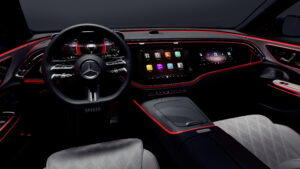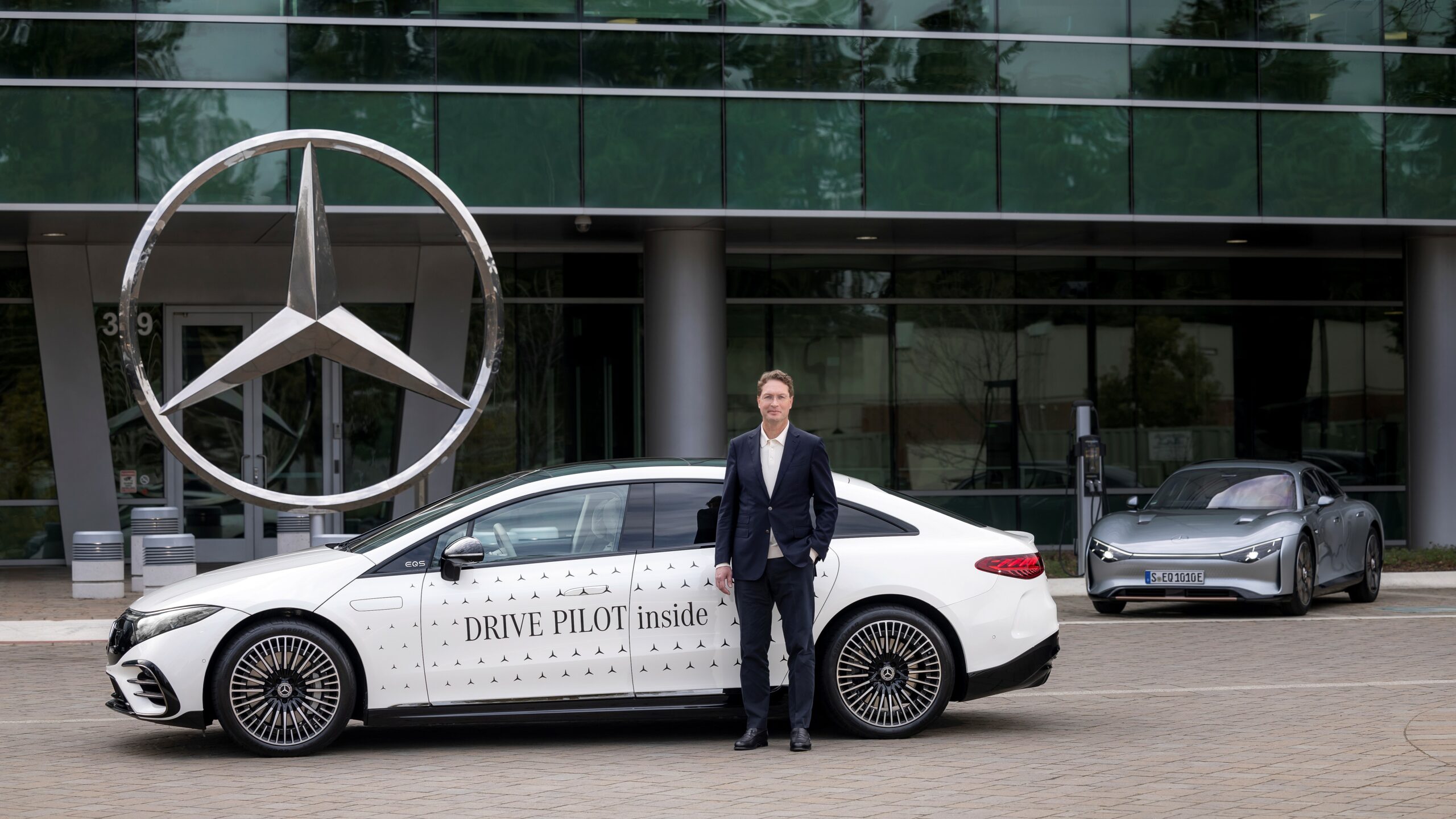
Mercedes details new lidar, operating system & infotainment in development
By Lurah Lowery onTechnology
Mercedes-Benz and Luminar have announced their expanded partnership that they say will safely enable enhanced automated driving capabilities across a broad range of the automaker’s lineup by mid-decade.
The initial production phase of “next-generation” Luminar IRIS lidar began in October 2022, and now that it’s proven successful, IRIS will soon be released with the new Mercedes Modular Architecture (MMA), according to a joint news release. IRIS can recognize even small objects with low reflectivity in the infrared spectrum.
After two years of close collaboration between the two companies, Mercedes says it will integrate IRIS and its associated software technology — tailored to meet the demanding requirements of the OEM’s new conditionally automated driving system — into its future vehicles to allow for higher operating speeds on freeways and enhanced driver assistance systems for urban environments.
Mercedes and Luminar calls the multi-billion dollar deal “a milestone moment” for both companies and the industry. They said it will “substantially enhance the technical capabilities and safety of conditionally automated driving systems.”
“Mercedes’ standards for vehicle safety and performance are among the highest in the industry, and their decision to double down on Luminar reinforces that commitment,” said Austin Russell, Luminar founder and CEO of Luminar. “We are now set to enable the broadest scale deployment of this technology in the industry. It’s been an incredible sprint so far, and we are fully committed to making this happen — together with Mercedes-Benz.”
Markus Schäfer, Mercedes-Benz Group AG Board of Management member and development and procurement chief technology officer, said the OEM wants to “implement advanced automated driving features in a broader scale within our portfolio.”
“I am convinced that Luminar is a great partner to help realize our vision and roadmap for automated and accident-free driving,” he said.
Mercedes was the first OEM to release Level 3 automated vehicles (AVs) in the U.S. Schäfer touted offering a Level 3 system in the OEM’s top-line models as a first step toward automated and accident-free driving.
Mercedes also announced last week that it has created the Mercedes-Benz Operating System (MB.OS), which the OEM described as a new purpose-built chip-to-cloud architecture that will be central to every future product and deliver exceptional software capabilities as well as ease of use for customers.
The automaker told Repairer Driven News that, at this point in time, there isn’t any information on what collision repairers should be aware of when it comes to IRIS, MB.OS, and the new infotainment system that will also be released. “More information will be available as we approach the market introduction,” Mercedes said.
MB.OS is designed and developed in-house to retain full control over the customer relationship, ensure data privacy, and leverage the unique integration of all car functions, according to Mercedes. The system benefits from full access to all vehicle domains, including infotainment, automated driving, body and comfort, and driving and charging.
“At Mercedes-Benz, we are dedicated to building the world’s most desirable cars,” said Mercedes CEO Ola Källenius. “Accordingly, we made the decision to be the architects of our own operating system — a unique chip-to-cloud architecture that leverages its full access to our vehicles’ hardware and software components. By combining this in-house expertise with a selection of world-class partners, we will create an outstanding customer experience, from driving assistance, navigation, and entertainment all the way to integrated charging. MB.OS will feature full upgradeability and constant improvements.”
MB.OS connects the major aspects of the OEM’s value chain, including development, production, omnichannel commerce, and services — effectively making it an operating system for the entire Mercedes-Benz business. “That’s why the effects of MB.OS range from decoupling development cycles to enhancing customer lifetime value long after the original car purchase,” a Mercedes news release states.
The operating system was created to be standardized across the entire vehicle portfolio, fully updateable for rapid product upgrades, and deliberately open for selected partners. One such partner is NVIDIA, which is providing its software, data, and artificial intelligence (AI) expertise as well as its NVIDIA DRIVE Orin system-on-chip to enhance benchmark SAE Level 2 and Level 3 automated driving systems, Mercedes said.
The focus for Mercedes is Level 3 conditionally automated driving with the ultimate goal of its vehicles driving at speeds of up to 80 mph in its final iteration. Level 3 is defined by SAE as fully automated meaning the driver isn’t required to take over unless asked by the system. Level 2 systems must be constantly supervised by the person in the driver’s seat to take over steering, braking, or accelerating.
Mercedes’ SAE Level 2 automated driving will start in the entry segment, “leveraging the full potential of machine learning.”
“A comprehensive set of sensors will be available in the MMA platform, which will also benefit from new dimensions of processing power,” Mercedes said. “The sensor setup will be designed to suit the high demands of urban environments, specifically the presence of pedestrians and dense, complex traffic patterns. Where local regulations allow, Mercedes-Benz customers will be able to enjoy more comfort, including hands-free driving while keeping eyes on the road.”
To achieve this, Mercedes and NVIDIA will build fully programmable and updateable driving automation systems. The “driving brain” of the vehicle will be the Orin system-on-chip, which is capable of conducting 254 trillion operations per second to process data from a suite of sensors surrounding the vehicle, according to Mercedes.
The system’s “eyes,” also called perception systems, alongside radar sensors and cameras, are lidar sensors from Luminar.
In China, Mercedes-Benz is engaging in a local cloud partnership with Tencent to support its automated driving systems with an enriched user interface, including an advanced lane-level map view.
As for Mercedes’ forthcoming new infotainment system, the OEM says it will be the first automaker to build its own branded navigation experience based on new in-car data and navigation capabilities from the Google Maps Platform, which will be embedded into MB.OS. It will also include YouTube use while parked or using Drive Pilot Level 3 (where permitted). Further expansion of the system will include in-car gaming and video conferencing, including Webex and Zoom.
“This aims to give the luxury carmaker access to Google’s leading geospatial offering, including real-time and predictive traffic information, automatic rerouting, and more,” Mercedes said. “To enrich the user experience, drivers will also be able to use the YouTube app on the infotainment system when parked and while using the DRIVE PILOT Level 3 conditionally automated driving system, where permitted. In addition, Mercedes-Benz will give customers access to Place Details provided by Google, helping them find detailed information about more than 200 million businesses and places around the world, including business hours, photos, ratings, and reviews.”
The infotainment system will also provide “precise and reliable” range management for electric vehicles (EVs). A precursor to MB.OS will be available in the new E-Class starting this year.
Images
Featured image: 2023 Mercedes-Benz E-class interior (Credit: Mercedes)
Mercedes-Benz previewed its operating system MB.OS during a strategy update on Feb. 22, 2023. (Credit: Mercedes)

